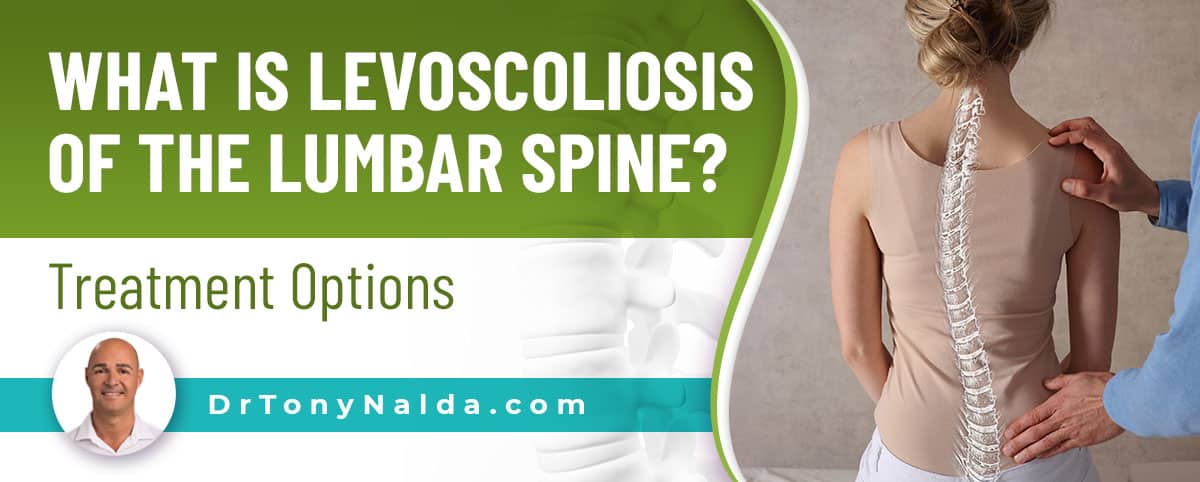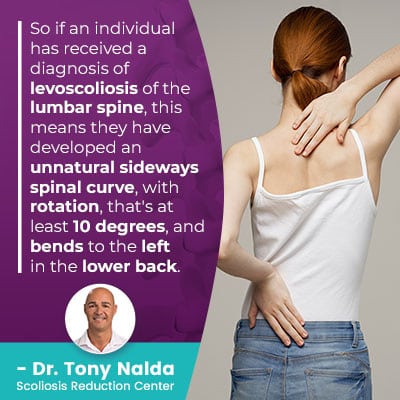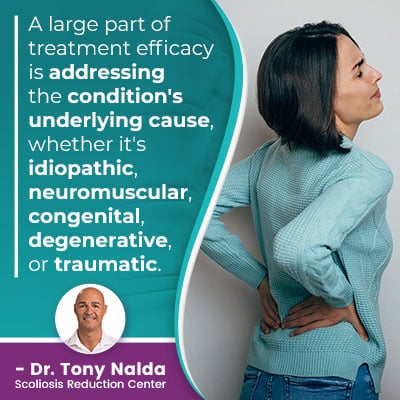What Is Levoscoliosis of the Lumbar Spine? Treatment Options

Part of diagnosing scoliosis cases involves comprehensive assessment to further classify conditions based on important patient/condition variables. Not only are there different condition types, there are also multiple curvature types and patterns: direction of the curve being one of them.
Levoscoliosis of the lumbar spine means an unnatural sideways spinal curve, that bends to the left, has developed in the lower back. As levoscoliosis is an atypical form, treatment plans are crafted around the condition's underlying cause.
To start our discussion on levoscoliosis treatment, let's first touch on some general condition information, for a better understanding of a typical, versus an atypical, form of scoliosis.
Table of Contents
What is Scoliosis?
For a person to be diagnosed with scoliosis, they have to have developed an unnatural sideways spinal curve, with rotation, making it a 3-dimensional condition.
In addition, the unnatural curvature of the spine has to be of a minimum size to be considered a true scoliosis: Cobb angle of 10+ degrees.
Cobb angle is known as the orthopedic gold standard in the assessment of scoliosis and is a measurement taken during X-ray that tells me how far out of alignment a scoliotic spine is.
A patient's Cobb angle also classifies conditions based on severity:
- Mild scoliosis: Cobb angle measurement of between 10 and 25 degrees
- Moderate scoliosis: Cobb angle measurement of between 25 and 40 degrees
- Severe scoliosis: Cobb angle measurement of 40+ degrees
- Very-severe scoliosis: Cobb angle measurement of 80+ degrees
Condition severity shapes the design of effective treatment plans, and as a progressive condition, scoliosis has it in its nature to worsen over time, particularly if left untreated, or not treated proactively.
So where a scoliosis is at the time of diagnosis is not indicative of where it will stay; mild scoliosis can easily progress to moderate, severe, or very severe, unless proactive treatment is applied to counteract the condition's progressive nature.
Other important classification points include patient age, curvature location, and condition type (cause), and the latter is where we get into the difference between typical and atypical forms of scoliosis cases.
Types of Scoliosis
As mentioned, there are different types of scoliosis a person can develop, and the majority of known diagnosed scoliosis cases are classified as idiopathic: approximately 80 percent.
Adolescent idiopathic scoliosis (AIS), diagnosed between the ages of 10 and 18, is the most prevalent form of scoliosis, and idiopathic scoliosis is also the most common type to affect adults.
Adult scoliosis patients who are diagnosed with idiopathic scoliosis were adolescents who had AIS but didn't receive a diagnosis and treatment during adolescence.
The idiopathic classification means not clearly associated with a single-known cause; instead, idiopathic scoliosis is thought to be multifactorial, meaning caused by different factors that can vary from person to person.
The second most common form to affect adults is degenerative scoliosis.
So cases of idiopathic scoliosis are considered typical, and the remaining 20 percent that are associated with known causes are considered atypical and have different condition features.
Atypical Scoliosis Cases
As mentioned, 80 percent of scoliosis cases are idiopathic, and the remaining 20 percent consists of forms associated with known causes: neuromuscular scoliosis, congenital scoliosis, degenerative scoliosis, and traumatic scoliosis.
These forms are considered atypical because they have unique condition characteristics.
Neuromuscular Scoliosis
Cases of neuromuscular scoliosis (NMS) are caused by the presence of a larger neuromuscular condition such as cerebral palsy, muscular dystrophy, or spina bifida.
While not all neuromuscular conditions will result in the development of scoliosis, it is a common complication caused by a disruption to the brain-body connection, connective tissues, and/or muscles that support the spine.
In cases of neuromuscular scoliosis, it's thought that scoliosis severity, and its progressive rate, is determined by the amount of nerve and muscle involvement associated with the underlying neuromuscular condition.
As the scoliosis is caused by the presence of a larger medical condition, this is also considered an atypical condition type.
Congenital Scoliosis
Congenital scoliosis is a rare form, affecting approximately 1 in 10, 000.
Infants are born with the condition as it's caused by a malformation within the spine itself that occurs in utero, as the spine is developing.
Often, this involves the failure of vertebrae (bones of the spine) to separate and form into distinct vertebral bodies, instead becoming fused together as one solid bone.
Vertebrae being misshapen can also cause the development of congenital scoliosis as the misshapen vertebrae can cause the spine to shift out of alignment and affect its ability to develop natural and healthy curves.
Degenerative Scoliosis
Degenerative scoliosis is most common in adults over the age of 40, and becomes increasingly prevalent with age.
Caused by natural age-related spinal degeneration, it's generally the spine's intervertebral discs that show the first signs of deterioration.
Certain negative lifestyle choices such as carrying excess weight, leading a sedentary lifestyle, chronic poor posture, and repeatedly lifting heavy objects incorrectly can also have a cumulative effect on the rate of spinal degeneration an individual faces with age.
The discs that sit between adjacent vertebrae provide the bones with cushioning, structure (adjacent vertebrae attach to the disc in between), facilitate flexible movement, and act as the spine's shock absorbers.
Once a disc starts to deteriorate, it can change shape, and this alters the position of adjacent vertebrae and can lead to the development of an unnatural sideways spinal curve.
Traumatic Scoliosis
Traumatic scoliosis is considered another atypical form of scoliosis because it's caused by the spine experiencing a significant trauma.
Car accidents and falls are common causes of spinal injuries that can lead to the development of traumatic scoliosis, as can the presence of spinal tumors pressing on the spine and forcing it out of alignment.
One of the ways I know if a patient's scoliosis is going to be a typical or atypical case is by the direction in which the scoliotic curve bends: levoscoliosis or dextroscoliosis.
What is Levoscoliosis?
Now, as mentioned, scoliosis is a highly-variable condition, meaning no two cases are the same, and there is no blanket approach to treating scoliosis; its complex nature necessitates the customization of effective treatment plans.
Not only does scoliosis vary widely in severity, and has different condition types with unique causes, part of further classifying a condition at the time of diagnosis is based on different curvature types and patterns, of which there are many.
In typical cases of idiopathic scoliosis, the scoliotic bend curves to the right, away from the heart, and this is known as dextroscoliosis; when a scoliotic curve bends to the left, towards the heart, this is levoscoliosis, is considered atypical, and is a red flag telling me there's likely an underlying pathology that's causing the scoliosis.
When I see a curve bending to the left, it's atypical and is a characteristic of neuromuscular, congenital, degenerative, and traumatic scoliosis.
Most often, dextroscoliosis spinal curves bend to the right in an 'S' shape, and levoscoliotic spinal curvature bend to the left in a 'C' shape.
 So if an individual has received a diagnosis of levoscoliosis of the lumbar spine, this means they have developed an unnatural sideways spinal curve, with rotation, that's at least 10 degrees, and bends to the left in the lower back.
So if an individual has received a diagnosis of levoscoliosis of the lumbar spine, this means they have developed an unnatural sideways spinal curve, with rotation, that's at least 10 degrees, and bends to the left in the lower back.
Levoscoliosis of the lumbar spine, ranging from mild, moderate and severe scoliosis, can manifest as distinct scoliosis pain, with sufferers often seeking to understand what does scoliosis pain feel like, and exploring various treatment options for managing the curvature.
Levoscoliosis of the lumbar spine, characterized by a leftward curvature, may prompt consideration of treatment options like swimming, known for its benefits in scoliosis management, particularly for alleviating hip pain and promoting natural spine alignment.
Symptoms of Levoscoliosis
Symptoms of levoscoliosis will vary based on a number of important patient/condition variables such as age and severity, but commonly include:
- Uneven shoulders
- Uneven hips
- Head uncentered over the torso
- Arms and legs that appear to hang at different lengths
- The development of a rib arch
- Ill-fitting clothing
Remember, as a progressive condition, the natural tendency of scoliosis is to worsen over time, and as a condition progresses, its symptoms tend to also become more severe and noticeable and can include:
- Localized back pain (more common in adult scoliosis)
- Radicular scoliosis pain felt throughout the body
- Lung impairment
- Chest pain
- Headaches that can reach migraine status
- Digestive issues
- Sleep problems
Although no two levoscoliosis cases will be the same, some of the aforementioned symptoms are considered indicators of the condition and/or the need for further testing.
Levoscoliosis Treatment Options
When it comes to levoscoliosis treatment options, based on the specifics of each individual condition, proactive and effective treatment plans can be crafted to impact the condition on every level.
Levoscoliosis of the lumbar spine, can be diagnosed through levoscoliosis radiology and manifests in forms such as mild rotatory levoscoliosis; treatment options for mild levoscoliosis include physical therapy and bracing, while severe cases may require spinal fusion to correct the lateral spinal curvature and prevent spinal cord compression.
Exploring treatment options for lumbar scoliosis, including levoscoliosis and rotoscoliosis, can significantly improve the quality of life for individuals dealing with these spinal conditions.
Here at the Scoliosis Reduction Center, I treat patients with a conservative chiropractic-centered treatment approach that customizes treatment plans to treat all condition types and severity levels.
As a structural condition, scoliosis has to, first and foremost, be impacted on a structural level in the form of a curvature reduction achieved through chiropractic treatment; once I see structural results, I can shift the focus to increasing core strength so the muscles around the spine are providing it with optimal support
 A large part of treatment efficacy is addressing the condition's underlying cause, whether it's idiopathic, neuromuscular, congenital, degenerative, or traumatic.
A large part of treatment efficacy is addressing the condition's underlying cause, whether it's idiopathic, neuromuscular, congenital, degenerative, or traumatic.
By integrating multiple scoliosis-specific treatment disciplines, patients of the Center benefit from what each distinct modality has to offer, and I can apportion them accordingly, based on how the spine is responding to treatment.
In-office therapy is used to increase core strength, and in addition, certain scoliosis-specific exercises (SSEs) are known to activate specific areas of the brain for improved brain-body communication, postural remodeling, and improved body positioning.
Through the use of corrective bracing, corrective results can be augmented as the spine is pushed into a corrective position.
Custom-prescribed exercises can help patients establish a home-rehabilitation program for further spinal stabilization and long-term sustainable treatment results.
Some patients often incorporate yoga and other forms of spine stretches into their treatment process as well.
Levoscoliosis of the lumbar spine can lead to scoliosis fatigue, but various treatment options, including physical therapy and bracing, can help manage symptoms and improve quality of life.
Levoscoliosis of the lumbar spine, a condition involving a lateral curvature of the lower back to the left side, is typically unrelated to C5-C6 disc bulging or the reversal of cervical lordosis, but it's important to note that severe scoliosis in any region of the spine can potentially cause numbness, and treatment options should be considered based on the specific type and location of scoliosis.
In order to craft an effective dextrolevoscoliosis treatment plan, the level of each patient's skeletal maturity, condition type, severity, curvature location, gender, and curvature type and pattern have to be taken into account.
The aforementioned patient/condition characteristics can also help me to predict a patient's likeliest progressive rate, and through monitoring and the application of proactive treatment, we can work towards counteracting the condition's progressive nature.
Conclusion
Scoliosis is a complex condition with different types, causes, severity levels, and curvature patterns.
In addition, scoliosis can develop in any of the spine's sections: cervical (neck), thoracic spine (middle/upper back), and the lumbar region (lower back).
In most cases of scoliosis, the unnatural spinal curve bends to the right, away from the heart, known as dextroscoliosis, but in atypical forms, the curve bends to the left, towards the heart, known as levoscoliosis.
In cases of levoscoliosis of the lumbar spine, this diagnosis means an unnatural sideways spinal curve, with rotation, and a Cobb angle measurement of 10+ degrees, that bends to the left in a 'C' shape, has developed in the lower back.
When I see this atypical curvature pattern, I know there's likely a larger underlying medical condition causing its development, and it's the underlying cause that has to drive the design of effective treatment plans.
Here at the Center, I use a modern conservative treatment approach to address the underlying structural 3-dimensional nature of scoliosis.
As a progressive condition, the best time to start scoliosis treatment is always now, regardless of condition type or severity; by being proactive, I can help patients work towards improvement in the spine's structure, function, and overall health.
While there are never treatment guarantees, regardless of condition type or severity, I work closely with my patients to make improvements to the spine’s structure, function, and overall health.
Dr. Tony Nalda
DOCTOR OF CHIROPRACTIC
After receiving an undergraduate degree in psychology and his Doctorate of Chiropractic from Life University, Dr. Nalda settled in Celebration, Florida and proceeded to build one of Central Florida’s most successful chiropractic clinics.
His experience with patients suffering from scoliosis, and the confusion and frustration they faced, led him to seek a specialty in scoliosis care. In 2006 he completed his Intensive Care Certification from CLEAR Institute, a leading scoliosis educational and certification center.
About Dr. Tony Nalda
 Ready to explore scoliosis treatment? Contact Us Now
Ready to explore scoliosis treatment? Contact Us Now





